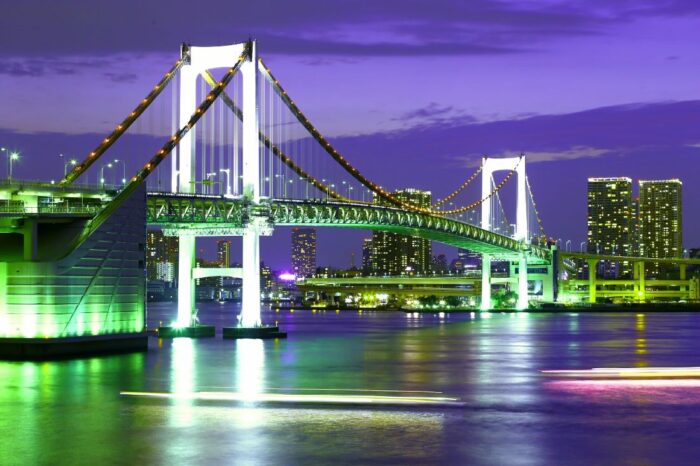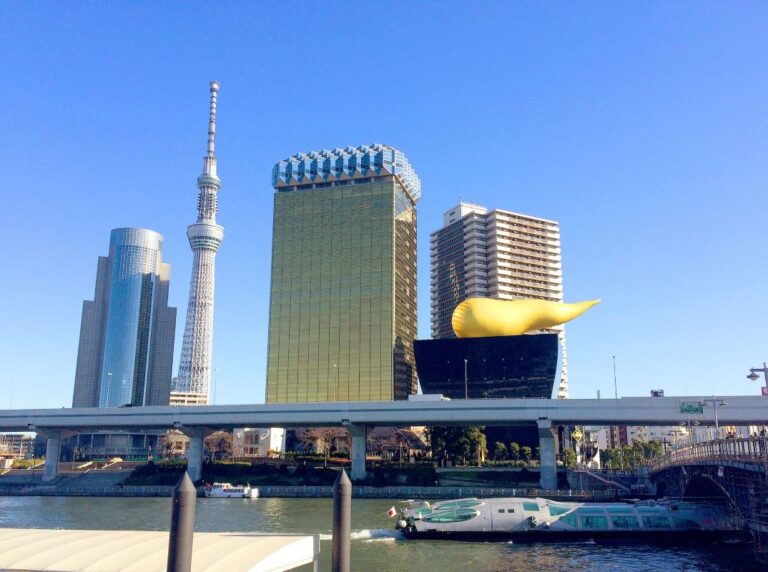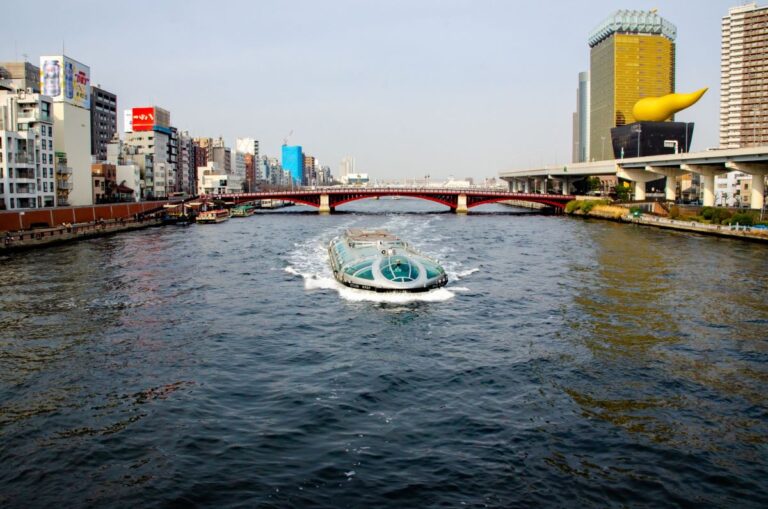Tokyo Bay, located in the southern Kantō region of Japan, is a significant body of water that spans the coasts of Tokyo, Kanagawa Prefecture, and Chiba Prefecture. It is connected to the Pacific Ocean by the Uraga Channel and plays a vital role in the economy and culture of the region.

The Tokyo Bay region is the most populous and largest industrialized area in Japan, making it an essential center for trade, transportation, and tourism. The bay is home to numerous ports, including the Port of Tokyo, which is one of the busiest in the world.
Location and Geography

Tokyo Bay is a large body of water located in the southern Kantō region of Japan. It is situated on the eastern coast of Honshu, the largest island of Japan. The bay is surrounded by three prefectures: Tokyo, Kanagawa, and Chiba.
The bay is approximately 120 km long and 20 km wide, with a total area of about 1,500 square km. It is connected to the Pacific Ocean via a narrow channel called the Uraga Channel. The bay has a maximum depth of around 60 meters and is relatively shallow overall.
The bay’s location has played a significant role in the development of Tokyo and the surrounding areas. The bay has been a vital transportation hub for centuries, with many important ports and harbors located along its shores. In addition to its economic importance, the bay is also a popular destination for recreational activities such as fishing, boating, and swimming.
History
Tokyo Bay has a rich history that dates back to the Edo period. During this time, the bay was primarily used for fishing and transportation. However, as Japan began to modernize in the late 19th century, the bay became an important location for industrialization and trade.
In the early 20th century, large-scale land reclamation projects were undertaken to create more space for industrial development. One of the most significant of these projects was the construction of the Port of Tokyo, which helped to establish Tokyo Bay as a major hub for international shipping.
During World War II, Tokyo Bay played a crucial role in the Pacific Theater. It was the site of several major battles, including the Battle of Tokyo Bay, which saw the Allied forces defeat the Japanese Navy and gain control of the bay.
In the post-war period, Tokyo Bay underwent significant redevelopment and modernization. The construction of several artificial islands, including Odaiba, helped to transform the bay into a major tourist destination and leisure area.
Today, Tokyo Bay remains an important economic and cultural center for Japan. Its history and development reflect the country’s ongoing evolution and transformation.
Economy and Industry

Tokyo Bay is one of the most important economic zones in Japan, and its development has played a significant role in the country’s economic growth. The bay’s location, with its access to the Pacific Ocean and proximity to major cities like Tokyo and Yokohama, has made it a hub for international trade and commerce.
The bay area is home to a diverse range of industries, including manufacturing, shipping, logistics, and tourism. The region is known for its advanced technology and innovation, with many of Japan’s leading companies having their headquarters here.
One of the most significant industries in the Tokyo Bay area is manufacturing, with companies producing everything from electronics to automobiles. The region is also home to several major ports, including Yokohama and Kawasaki, which handle a large volume of cargo each year.
The tourism industry is also a significant contributor to the bay area’s economy, with millions of visitors coming to the region each year. The area is home to several popular attractions, including Tokyo Disneyland and the Tokyo Tower, as well as numerous museums, parks, and shopping districts.
In recent years, the Tokyo Bay area has become a leader in sustainable development, with several initiatives aimed at reducing the region’s environmental impact. These include projects to reduce carbon emissions, promote renewable energy, and improve waste management.
Environmental Concerns
Tokyo Bay is a vital part of the city’s ecosystem, but it is also facing numerous environmental concerns. Pollution and eutrophication caused by pollutants entering the bay are the most serious environmental problems. The bay is also facing issues with carbon cycling, nutrient load, and tidal flats.
Coastal urbanization has led to changes in carbon cycling in the bay. According to a study by Kubo et al. (2020), sewage treatment in urbanized areas of the Tokyo Bay catchment has largely contributed to changes in carbon cycling between the 1970s and the present. This has led to an increase in organic carbon deposition in the bay, which can cause eutrophication and negatively impact the ecosystem.
The bay’s nutrient load is another major concern. Nutrients from agricultural runoff, sewage, and other sources can lead to eutrophication, which can cause harmful algal blooms and oxygen depletion. Anoxic water, which lacks oxygen, can be deadly for fish and other aquatic life. The blue tide phenomenon in Tokyo Bay, caused by a type of harmful algal bloom, has also had a negative effect on shellfish in the area (Furukawa, 2006).
The bay’s tidal flats are also under threat. Tidal flats are important habitats for many species, but they are vulnerable to development and land reclamation. The loss of tidal flats can have a significant impact on the ecosystem, as well as on the livelihoods of local communities that depend on fishing and other activities in the bay.
Addressing these environmental concerns is crucial for the health of Tokyo Bay and the well-being of the people and wildlife that depend on it. The Tokyo Bay eSG Project, launched by the Tokyo Metropolitan Government, aims to address these issues and promote sustainable development in the bay area (Tokyo Metropolitan Government, n.d.).
Tourism and Recreation

One of the most popular areas for tourism is Odaiba, a man-made island in the bay. Here you’ll find a variety of attractions, including the Fuji TV building Observation decks, the Daiba Haunted School, and the Miraikan science museum. You can also enjoy shopping, dining, and entertainment at the many malls and arcades in the area.
Outdoor enthusiasts will love the many parks and beaches around Tokyo Bay. The Hama-rikyu Gardens offer a peaceful escape from the city, with traditional Japanese gardens and a teahouse. The Kasai Rinkai Park is home to an aquarium, a bird sanctuary, and a Ferris wheel with panoramic views of the bay. And of course, there are several beaches where you can swim, sunbathe, and enjoy water sports.
Finally, no visit to Tokyo Bay would be complete without a trip up the Sumida river to the Tokyo Skytree. This towering structure offers stunning views of the city and the bay, with observation decks at 350 and 450 meters. You can also enjoy shopping and dining at the Skytree Town complex at the base of the tower.
The Sum Up

Tokyo Bay is a vibrant and dynamic body of water that has played a significant role in Japan’s history, economy, and culture. Its strategic location and natural resources have made it a popular destination for tourists, sailors, and fishermen alike.
As the largest industrialized area in Japan, Tokyo Bay is home to a wide range of businesses and industries that contribute to the country’s economic growth. From shipping and logistics to manufacturing and technology, Tokyo Bay is a hub of innovation and progress.
Despite its urbanization, Tokyo Bay is also a natural wonder that is home to a diverse array of flora and fauna. From the majestic Mount Fuji to the beautiful cherry blossoms, Tokyo Bay is a testament to Japan’s natural beauty and rich history.
Where To Stay In Tokyo
Tokyo visitor levels are currently at an all-time high so make sure to book your hotels early. Tip most hotels booked with booking.com have free cancelation so book as soon as you know your date and you can always cancel if you change your mind.






